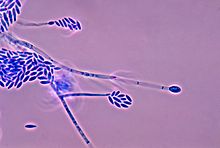| Fusarium | |
|---|---|

| |
| Fusarium verticillioides | |
| Scientific classification | |
| Domain: | Eukaryota |
| Kingdom: | Fungi |
| Division: | Ascomycota |
| Class: | Sordariomycetes |
| Order: | Hypocreales |
| Family: | Nectriaceae |
| Genus: | Fusarium Link (1809)[1] |
| Species | |
| Synonyms[2] | |
|
List
| |
Fusarium is a large genus of filamentous fungi, part of a group often referred to as hyphomycetes, widely distributed in soil and associated with plants. Most species are harmless saprobes, and are relatively abundant members of the soil microbial community. Some species produce mycotoxins in cereal crops that can affect human and animal health if they enter the food chain. The main toxins produced by these Fusarium species are fumonisins and trichothecenes. Despite most species apparently being harmless (some existing on the skin as commensal members of the skin flora), some Fusarium species and subspecific groups are among the most important fungal pathogens of plants and animals.
The name of Fusarium comes from Latin fusus, meaning a spindle.
- ^ Link, Johann Heinrich Friedrich (1809). "Observationes in ordines plantarum naturales. Dissertatio I." Magazin der Gesellschaft Naturforschenden Freunde Berlin (in Latin). 3 (1): 10.
- ^ Cite error: The named reference
Species Fungorum synonymywas invoked but never defined (see the help page).